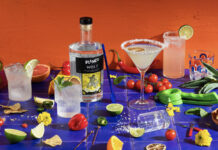
Born a Nashville native, Darek Bell runs one of the most awarded and popular distilleries in the craft world: Corsair Distillery, recently awarded the Bubble Cap Award as 2014 Craft Distiller of the Year at ADI’s 11th annual Spirits Conference in Seattle this April.
Bell started homebrewing beer, wine and sake before taking on distilling. Venturing on a pilgrimage to the Isle of Islay, he studied Scotch production at the Bruichladdich Distilling Academy and developed a love for smoked whiskeys. Bell formed Corsair with his childhood friend, and fellow homebrewer/winemaker, Andrew Webber. In his book, Alt Whiskeys, Bell shares his experiments with alternative and smoked grains, and unusual botanicals.
In his own words, Bell tells us about how he got here, keys to success, what the Bubble Cap award means to him, and shares valuable advice for fellow distillers.
How did you get into craft distilling? Tell us your history.
I started off as a homebrewer making beer, wine, and sake. Homebrewing completely changed my life. The more I did it, the more addicted I became. I would carefully plan all week pulling together different ingredients and supplies so I could have an amazing weekend of brewing. I became more and more obsessed with it. It was such a great mixture of left brain and right brain. It was creative yet incredibly technical. And I loved it, deliriously. There was a real excitement that brewers were creating new exciting beers the world had never seen before. This became the real addiction. It is what got me pumped, excited, and made me feel really alive. Brewing was my gasoline.
Andrew Webber, who was a friend and now business partner, started making other things together like wine, sake, ciders, and mead. We started making biodiesel for an old
junker 80’s diesel Mercedes we bought. One day while sweating over a nasty batch of biodiesel, Andrew turned to me and said, “I wish we were making whiskey.” Bam! Just like that we shifted our focus, began building stills, and making spirits. The more we did it, the more we were able to tweak what we were doing and really make better and better stuff. My wife, Amy Lee Bell, was concerned that it was illegal, and asked me to either get licensed or find a new hobby. I am glad she did and she is now the third partner in our venture.
We decided to start Corsair, with the goal of being the first distillery in Nashville. Unfortunately the laws would not allow it, so we started our first distillery an hour’s drive away in Bowling Green, Kentucky. It took us a year to change the law in Tennessee to allow us to open there and another 9 months to change a local ordinance.
Andrew was getting his MBA at Vanderbilt University and noticed that there were so many distilleries in Kentucky, but only two in Tennessee and until very recently. The laws had been protecting the existing distilleries and this gave us a good business case for starting our distillery. We thought maybe, just maybe, we could succeed in an industry of giants.
How do you decide which spirits you want to distill?
Because we are in the shadow of massive distilleries here in Tennessee, we decided early on to focus on very unusual whiskeys to differentiate ourselves. We cannot possibly compete with them in terms of marketing dollars and so try not to. So from day one we decided to be respectful of
tradition but make whiskeys that were anything but. I believed there was a new generation of drinkers coming who did not want to drink what their parents drank. Given how traditional and conservative whiskey had been, I thought it was an industry ripe for disruption by new creative companies.
We have some major attention deficit disorder. We like trying new things. We make about 100 new whiskey recipes a year, the top ones we enter into competitions. If they win, they go on to become production whiskeys. We do not make a standard Kentucky Bourbon or Tennessee Whiskey even though we have distilleries in those states and could do so with authenticity. Why not just make a safe and standard bourbon and laugh all the way to the bank? Because it has already been done. We want to create new styles of whiskey. To boldly go where no other whiskey geeks have gone before!
What do you most love creating/distilling/producing?
We are continually looking for new ideas and new ways to differentiate ourselves from traditional, mainstream whiskey. We make whiskeys that use mash bills that utilize unusual grains like quinoa or malts used in brewing but rarely in distilling, such as chocolate rye malt, biscuit malt, or caramel 120. We distill beer to make hopped whiskeys or whiskeys that are influenced strongly by the beer they are distilled from. Our brewing background has strongly inclined our approach. There are so many malts and grains used in beer making that for some reason distillers have never used. One of our favorite sayings around Corsair is, “Beer is simply whiskey that hasn’t yet reached its true potential.”
What have been the greatest keys to your success?
Fearless experimentation. Corsair makes unique, innovative, and unusual products that do not easily fit into existing whiskey categories. Our motto is simple: If it has been done before we do not want to do it. Our goal is to expand the horizons of whiskey making. We do this by making distinctive whiskeys no one else has ever made. Whiskey is very traditional and conservative. We are not.
For example, we always loved smoked whiskeys. We also noticed an important trend. In general, the older the whiskey, the better the score in the magazines and in competitions. However, for smoked whiskeys this was not the case. For example, the 5 year old Bruichladdich Octomore will often do better than the 30 year old Bruichladdich that is barely peated. This was an important realization for us. As a new distillery we cannot compete on age, yet. If you do not tell the consumer what is unique, they judge you based on age. If you tell them to focus on something else, like because it is smoked with cherry wood or made with amaranth, you change the focus away from age to something else that is special about the whiskey. Also, if there are a hundred whiskeys, or several hundred, touting the age, why compete with them with what they are good at. I would rather create a new category and be judged differently. How many quinoa whiskeys are we competing with? None. How many cherry wood smoked Bourbons? Zero.
What difference does winning awards or gaining press recognition have on your business?
Winning an award like the bubble cap is incredibly vindicating to us. Competing in international spirits competitions is incredibly rewarding as you get great feedback on your spirits. These awards help solidify the idea that our philosophy and techniques for our spirits are not only different but well made and deserving of these accolades. We see a huge impact in terms of sales when we win big awards. The industry really takes notice and sales are directly related.
Tell us about the trajectory of Corsair from the early days in one location to your larger operation in two locations.
In the beginning the laws in Tennessee did not allow us to distill in Nashville. We started in Bowling Green with a small 2400 sq ft space. Last year we added an additional 6000 sq ft. It took a year to change the state law to allow us to open our Nashville distillery. We opened our 5000 sq ft Nashville distillery in 2010. The Nashville distillery is focused on whiskey and the Bowling Green facility is focused on white spirits like gin. We added a 2400 sq ft malting facility on our family farm in Nashville early this year and are in the process of buying two new buildings that will add an additional 30,000 sq ft of production space, brewing space, distilling space, and barrel storage. We think this will last us for another 5 years.
How has the climate for distillers and the spirits industry changed since you began a few years ago?
In the beginning distributors, retail, and suppliers did not get craft spirits. They understood craft beer, but some of them did not believe craft spirits could get off the ground. For example, we called a bottle company that would only sell by the truckload. We could not possibly afford that or even store that much glass. We asked if we could buy only a few cases of glass, and of course they died laughing. Now the glass companies are calling us trying to get in the door with short orders and they would not even talk to us in the beginning.
What do you most love to drink in your “off” hours?
I drink as many different things as I can. I am always looking for new things to try. I am a big fan of Islay Scotch, especially heavy smoky and peaty Scotch. I also love craft beer, the “hoppier” and darker the better. Whenever I try a beer I wonder what it would taste like distilled, so I try and keep up with craft beer as much as I can. I also think craft beer is so creative right now.
Where do you see yourself and Corsair in five years?
We recently built our own malting facility on my family farm. There are only a few smoked malts on the market. Growing, malting, and smoking our own grains will allow us to further differentiate ourselves from other distillers. To expand our smoked whiskey capabilities we had no choice but to build our own malting facility to allow us to make many more smoked malts and further refine our smoked whiskeys. I am about to release another book, on smoked whiskeys called Fire Water. We have made 80 different smoked whiskeys utilizing every possible smoke we can get our hands on: from alder wood to white oak and every species in between. Utilizing our family farm along with our malthouse, this will allow us to do true ‘grain to glass’ whiskey.
We have also built up a massive library of smoked whiskeys using a number of exotic fuel sources. We found that smoked whiskeys really benefit from blending different types. The problem is that some types of smoke are great for the nose, some great for the palate, and others for the finish but they rarely work well in all three. When you are being judged in competitions or for magazines, the judges want to see quality in all three: N,P, and F. For example, a white oak smoked malt makes a great base smoke that gives a lot of punch to the palate. Sadly it has no finish and the nose is unremarkable. If you blend in a fruit wood smoke, say pear tree or cherry tree, it really gives a great nose and adds a pleasant sweetness to the front of the spirit. It gets lost on the finish though. Maple wood adds a great finish. By blending these three together you create a whiskey with much more depth and dimension that will be judged far more favorably. We have also made a large number of alternative grain based whiskeys using things like quinoa, teff, amaranth, buckwheat, etc. We can also use these for blending. For example, amaranth whiskey by itself is not that remarkable, however when paired with Hickory smoked malt, it really resulted in a remarkable smoked whiskey. Now that we have this library we can work on new blends at a faster pace. All this allows us more room for creativity and to dial in and refine certain flavors. These individual whiskeys are all new colors and brushes. The blends are the canvas.
In the next 5 years expect lot of new and unusual whiskeys out of Corsair.
What do you see as the current environment for craft/micro distillers and what advice would you give to those wanting to break into the business?
It’s getting more competitive. A lot of distilleries have popped up in a short amount of time. As with anything, competition breeds excellence. There are a lot of people buying sourced whiskeys. There is now a backlash against these ‘fake distilleries’ capitalizing off the craft distilling movement, but not actually adding any thing authentic or new for the whiskey lover.
My advice is to find what is unique about you and make a whiskey that expresses this. Stand out from the crowd.








